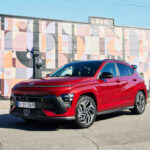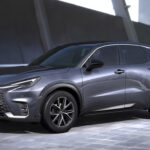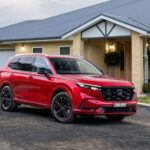
Hyundai’s mid-sized SUV Tucson has been around since 2004. The current (fourth
generation) was released here in February 2021.
There are three variants: Tucson, Tucson Elite and Tucson Highlander with three
powertrains: 2.0-litre petrol, 1.6-litre turbo-petrol and 2.0-litre turbo-diesel engines. Hybrid
and plug-in hybrid are available overseas but are unlikely to come here in the near future
due to RHD production constraints.
Our test vehicle was the Highlander 1.6-litre turbo-petrol AWD priced at $50,000 plus on-
road costs.
STYLING
We love the adventurous new styling route that Hyundai is taking and, like the IONIQ 5
and Staria that we’ve reviewed recently, the latest Tucson is a real head-turner. The large
hatched grille gives a bolder look than before and is fringed by five LED daytime running
lights in a crescent formation. The headlights are full LED and automatically adjust to the
sides for improved cornering visibility.
The Gen 4 Tucson sits on a longer wheelbase than its predecessor with a longer bonnet
and shorter overhangs on the outside and extra cabin space.
All variants can be enhanced by N Line Option Packs which add sports-inspired styling
(but not performance) including N Line rear spoiler, silver skid plate, bumper, body-
coloured cladding and 19-inch alloy wheels. Prices vary according to standard features so
$3500 for the base Tucson, $2000 (Elite) and $1000 (Highlander).
Profile takes the coupe-like roofline that’s currently in fashion and is topped with
contrasting black roof rails. The wheel arches, rather than following the round shape of the
wheels, come in a distinctive angular shape.
The rear comes with wide-set lighting with the Hyundai badge embedded into the rear
glass.
There are seven exterior colour choices, six of them costing an extra $600.
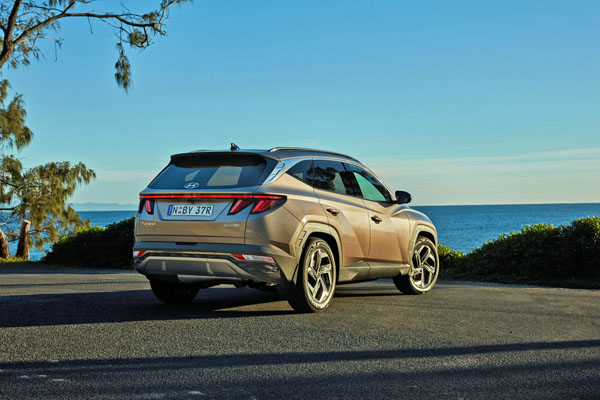
INTERIOR
Inside the Tucson the styling is neat and functional rather than trying to match the exterior
flare. The seats are large, firm and comfortable and all the controls are well-positioned and
easy to operate with minimum driver distraction.
There’s a classy look all around with a bridge-style centre console, powered leather front
seats (Elite and Highlander), heated front seats and electrically adjustable driver’s seat,
dual-zone air-conditioning, smart key and push-button engine start / stop.
The range-topping Tucson Highlander gets a powered sunroof.
The longer wheelbase provides excellent legroom in all seats and there’s plenty of front
and rear headroom.
The boot holds up to 539 litres with the rear seatbacks in place and 1860 litres when they
are folded. The floor is flat across its full length, there’s a full-size spare wheel beneath.
A rear seat alert reminds the driver to ensure the seats are empty when leaving the
vehicle.
ENGINES / TRANSMISSIONS
Three powertrains are offered. All variants get the option of a 2.0-litre petrol engine
generating 115 kW of power and 192 Nm of torque paired with a six-speed automatic and
front-wheel drive is available in all variants.
Elite and Highlander add the choice of a 1.6 turbo-petrol (132 kW and 265 Nm) with
seven-speed DCT and all-wheel drive, or a 137 kW / 416 Nm 2.0 turbo-diesel with eight-
speed torque convertor automatic and AWD. Both have pushbutton gear selection and
shift paddles.
The official fuel consumption is 8.1 litres per 100 kilometres from the 2.0-litre petrol; 7.2
L/100 km from the 1.6-litre turbo-petrol with the diesel at 6.3 L/100 km.
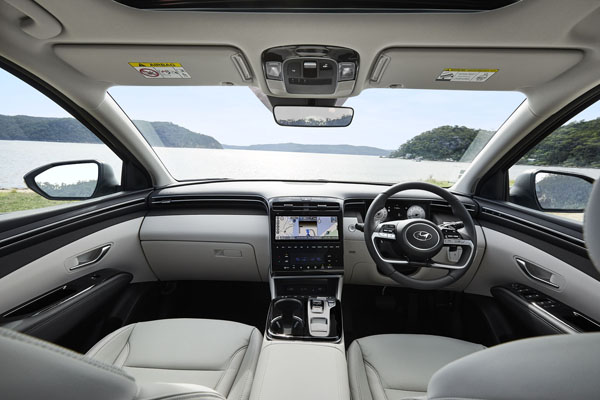
INFOTAINMENT
All models have touchscreen multimedia displays embedded into the middle of the
dashboard, 8-inch in the entry level Tucson and a larger 10.25-inch in the Elite and
Highlander to cater for satellite navigation and live traffic updates. It comes with the option
of wide-screen or split-screen view of map or navigation and audio.
Likewise, the Tucson has a smaller (4.2-inch) digital instrument cluster than the 10.25-inch
display in the two higher variants. All have a digital speedometer.
There are short-cut buttons below the screen for the most commonly-used features.
Apple CarPlay and Android Auto are available across the range, wireless in the Tucson
and connected in the higher spec models.
DAB+ digital radio is also standard in Elite and Highlander but, given that we live outside
the Sydney metropolitan area, it was pointless trying to use it. Indeed, because the radio
defaulted to DAB+ stations rather than to FM we found it frustrating to use.
The flagship Tucson Highlander features an eight-speaker Bose premium audio system.
Tucson and Elite have a six-speaker unit.
SAFETY
All Tucson models come with the same comprehensive list of safety features starting with
front, side (thorax), curtain. A front-centre airbag stops serious injuries by preventing the
driver and the front passenger from hitting each other.
Other passive safety features include; roll-over sensor; stability and traction control
including trailer stability control; enhanced ABS brakes; emergency stop signal; tyre
pressure monitoring; hill-start assist and multi-collision braking.
The Hyundai Smartsense suite adds advanced features such as smart cruise control;
forward collision avoidance assist (including pedestrians and cyclists); blind-spot collision
avoidance assist; blind spot view monitor; driver inattention warning; leading vehicle
departure alert; remote parking assist and surround view monitor (Highlander only);
parking collision avoidance assist; lane follow assist; intelligent speed limit assist;
intelligent speed limit assist; safe exit warning; and rear cross-traffic collision avoidance.
All variants have a rear-view camera and rear parking sensors, with front sensors added in
the Elite and Highlander.
DRIVING
Entry into Tucson only needed the minimum degree of bending and once ensconced
behind the wheel the seats are comfortable and supportive. Visibility is excellent in all
directions and the driving position is relatively high.
Both the front seats in the Highlanders are powered with the driver also getting a memory
function. The steering wheel has height and reach adjustments.
Unlike most previous Hyundai models, the Tucson didn’t get the Australian local ride-and-
handling input. However, the engineers at the company’s Namyang R&D centre have
learnt enough from previous Australian tests to be able to mirror our challenging
conditions. They’ve done a good job and Tucson is well-balanced with a firm but
comfortable ride. Steering is relatively heavy but direct.
The Tucson’s cabin is quiet and refined, well-suited for long distance cruising.
Fuel consumption is listed at 7.2 litres per 100 kilometres, we averaged 8.1 during our test.
SUMMING UP
Tucson has been one of the fixtures in Hyundai’s SUV range since its launch in 2004. For
the past 17 years, the original 2WD City version has been providing yeoman’s service to
my younger son and his family. It started as the single car for his young family, took
second stage as they outgrew it and became a work commuter and most recently as a
learner vehicle for our two grandsons.
Over the years we’ve watched Tucson evolve from its conservatively styled roots into what
is now one of the best-looking vehicles in its class. These fresh new looks together with its
well-earned reputation for reliability and convenience certainly make Tucson worth
including in your test drive roster.
AT A GLANCE
MODEL LINE-UP
Tucson 2.0 petrol FWD: $34,500
Tucson Elite 2.0 petrol FWD: $39,000
Tucson Highlander 2.0 petrol FWD: $46,000
Tucson Elite 1.6 turbo-petrol AWD: $43,000
Tucson Highlander 1.6 turbo-petrol AWD: $50,000
Tucson Elite 2.0 diesel AWD: $45,000
Tucson Highlander 2.0 diesel AWD: $52,000
Note: These prices do not include government or dealer delivery charges. Contact your
local Hyundai dealer for drive-away prices.
SPECIFICATIONS (Hyundai Tucson Highlander 1.6-litre turbo-petrol AWD five-door
wagon)
ENGINE:
Capacity: 1.598 litres
Configuration: Four cylinders in line
Maximum Power: 132 kW at 5500 rpm
Maximum Torque: 265 Nm at 1500
Fuel Type: Petrol 91 RON
Combined Fuel Cycle (ADR 81/02): 7.2 L/100km
CO2 emissions 164 g / km
DRIVELINE: Seven-speed automatic, all -wheel drive
DIMENSIONS, WEIGHT AND CAPACITIES:
Length: 4630 mm
Wheelbase: 2755 mm
Width: 1865 mm
Height: 1665 mm
Turning Circle: 11.8 metres
Kerb Mass: 1560 kg
Fuel Tank Capacity: 54 litres
BRAKES:
Front: Ventilated disc
Rear: Solid disc
STANDARD WARRANTY:
Five years / unlimited kilometres
RATINGS
Looks: 9/10
Performance: 7/10
Safety: 9/10
Thirst: 7/10
Practicality: 8/10
Comfort: 8/10
Tech: 8/10
Value: 7/10




